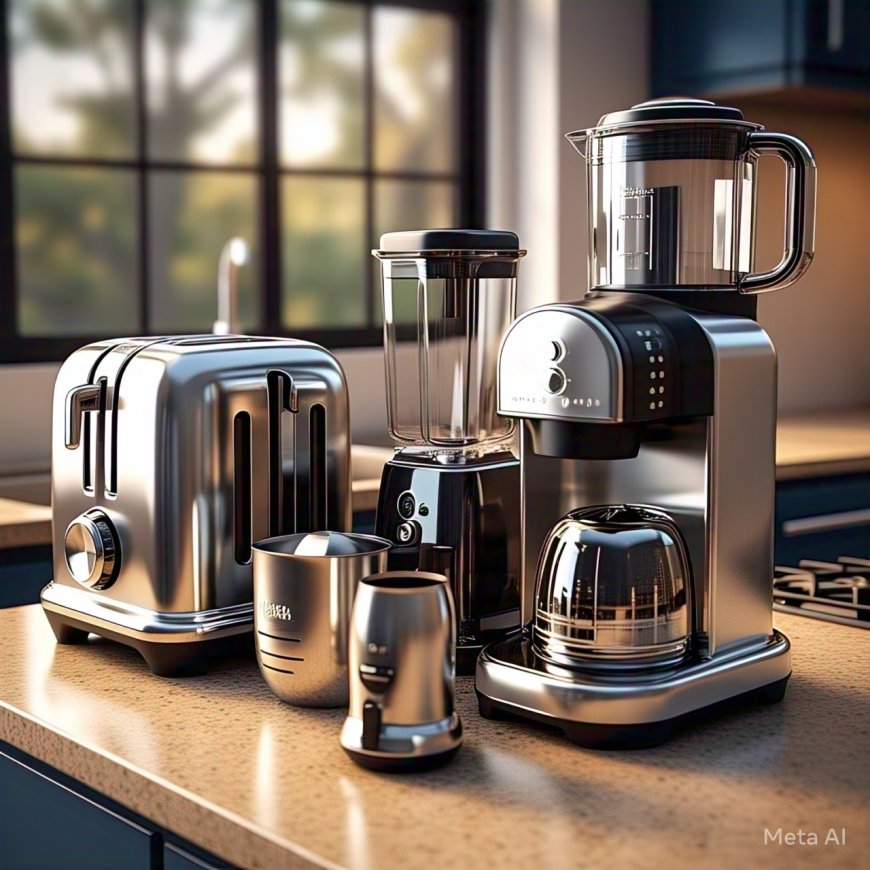United States Small Kitchen Appliances Market Insights 2021-2030| Growth & Opportunity Analysis
The United States Small Kitchen Appliances Market is projected to reach USD 7.8 billion by 2033 from USD 4.98 billion in 2024, growing at a CAGR of 5.12%

United States Small Kitchen Appliances Market Size and Share Analysis - Growth Trends and Forecast Report 2025-2033
Market Overview
The United States Small Kitchen Appliances Market is projected to reach USD 7.8 billion by 2033 from USD 4.98 billion in 2024, growing at a CAGR of 5.12% during the forecast period. The market is witnessing robust growth due to increasing demand for smart, energy-efficient, and multifunctional kitchen appliances that enhance convenience and complement modern lifestyles. With the surge in home cooking, rising health consciousness, and expanding e-commerce platforms, the market is poised for consistent expansion.
Market Description
Small kitchen appliances include portable or semi-portable devices used for food preparation and related culinary tasks. These include air fryers, blenders, toasters, food processors, coffee makers, and electric kettles. In the United States, these appliances are widely used in both residential and commercial kitchens due to their ease of use, efficiency, and compact size.
Press Release
April 2025 – United States Small Kitchen Appliances Market Accelerates Toward USD 7.8 Billion by 2033, Driven by Smart Tech and Healthy Eating Trends
According to the latest market study, the U.S. small kitchen appliances sector is on a transformative growth path. With an anticipated value of USD 7.8 billion by 2033, consumers are increasingly gravitating toward smart, stylish, and sustainable kitchen solutions. Companies like Midea, Drew Barrymore's "Beautiful" brand, and PowerXL are redefining culinary convenience with programmable air fryers, smart coffee makers, and auto-stirring multi-cookers. The market reflects a clear shift: Americans are cooking more at home and demanding technology that enhances both function and form.
Market Dynamics
Growth Drivers
1. Demand for Smart and Energy-Efficient Appliances
Consumers are favoring appliances that integrate with smart home ecosystems. Features like Wi-Fi connectivity, voice assistance, app control, and programmable settings are becoming standard. In January 2024, Drew Barrymore's "Beautiful" brand released a range of affordable, visually appealing smart appliances designed for ease and elegance.
2. E-Commerce Boom
Online channels are accelerating market penetration. Platforms like Amazon and Walmart.com offer wide product selection, competitive pricing, and customer reviews. Brands are embracing direct-to-consumer strategies for better margins and personalization. In November 2024, PowerXL launched its Stirmax Multi-Cooker online, showcasing tech-forward convenience.
3. Home Cooking & Healthy Living Trends
Consumers are investing in appliances that support wellness goals. Air fryers, slow cookers, and smoothie blenders are in high demand. In February 2025, Midea launched the Flexify Pro Air Fryer Oven at KBIS 2025, underscoring how innovation is elevating meal prep experiences at home.
Market Challenges
1. Competitive Landscape & Pricing Pressure
With a saturated market, established brands like KitchenAid and Cuisinart face pressure from emerging players offering affordable alternatives. Price sensitivity remains a hurdle, especially as brands try to balance affordability with innovation.
2. Supply Chain & Inflation
Global supply chain bottlenecks, especially for semiconductors and steel, are inflating production costs. These issues, compounded by inflationary trends, are challenging manufacturers to optimize sourcing and inventory management.
Segmental Analysis
By Product
- Coffee Makers: Strong growth due to the U.S. coffee culture and work-from-home trends. Smart models with app integration are becoming mainstream.
- Toasters: Consumers prefer stylish, multi-setting models with safety and design upgrades.
- Food Processors & Blenders: Popular for health-conscious buyers aiming for efficient meal prep.
- Air Fryers & Roasters: Increasingly in demand as alternatives to traditional frying methods.
By Distribution Channel
- Online Platforms: Fastest-growing segment. Online promotions, bundled deals, and D2C strategies are driving sales.
- Electronic Stores: Remain important due to the hands-on experience and availability of demos, especially at Best Buy and Home Depot.
- Supermarkets & Brand Outlets: Benefit from high footfall and brand visibility.
By End User
- Residential: Largest segment due to rising interest in home cooking, kitchen remodeling, and smart home integrations.
- Commercial: Includes restaurants, hotels, and cloud kitchens. Preference for high-capacity, durable, and efficient appliances.
By Region
- West: Tech-savvy consumers in states like California prioritize smart, sustainable, and aesthetically pleasing appliances.
- East: Urban dwellers demand compact, multifunctional appliances. E-commerce dominates sales.
- North & South: Emerging demand from suburban households and growing urban centers.
Competitive Landscape
Key Players
- Hamilton Beach Brands Holding Company
- CEO: Gregory H. Trepp
- Recent Developments: Focus on affordable, smart appliances.
- Revenue: USD 640 million (2024 est.)
- Newell Brands
- CEO: Christopher Peterson
- Recent Developments: Expansion of Oster and Mr. Coffee smart product lines.
- Spectrum Brands
- Key Brands: Black+Decker
- Focus: Energy-efficient models and growing D2C presence.
- Breville Group Limited
- Known for: Premium blenders, espresso machines, and ovens.
- Innovations: App-connected cooking tools.
- Gourmia
- Focus: Affordable air fryers and multicookers.
- Strength: Strategic presence in Walmart and online platforms.
- Smeg SpA
- Style-first brand with European flair, appealing to premium segment buyers.
- Electrolux AB
- Investing in smart cooking solutions and eco-friendly materials.
- Whirlpool Corporation
- Expansion into smart kitchen product lines with focus on AI integration.
Conclusion
The United States Small Kitchen Appliances Market is in the midst of a smart transformation. Fueled by the convergence of health consciousness, digital innovation, and e-commerce convenience, the market is expected to maintain steady growth through 2033. With changing consumer preferences and advancing technologies, manufacturers that align with smart home integration, sustainability, and stylish design will likely lead the next wave of market dominance.





































































![https //g.co/recover for help [1-866-719-1006]](https://newsquo.com/uploads/images/202506/image_430x256_684949454da3e.jpg)



























![[PATREON EXCLUSIVE] The Power of No: How to Say It, Mean It, and Lead with It](https://tpgblog.com/wp-content/uploads/2025/06/just-say-no.jpg?#)






















































